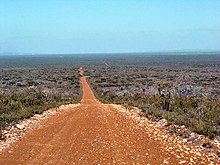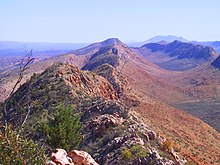Outback



Outback refers to remote and arid areas of Australia, although the term colloquially can cover any lands outside of the main urban areas. The term "outback" is generally used to refer to locations that are comparatively more remote than those areas deemed "the bush". The outback does not officially exist within any governmental frameworks or boundaries. Many local government shires do use the term to enhance tourist appeal for their own shire. The outback is home to the Australian feral camel and dingoes. The Dingo fence was built to restrict dingo movements into agricultural areas towards the south east of the continent.
The marginally fertile parts, mainly within the Lake Eyre Basin, are known as rangelands and have been traditionally used for sheep or cattle farming, on sheep stations and cattle stations which are leased from the Federal Government. Whereas these grassy areas have fairly fertile clay soils, the remainder of the outback has exceedingly infertile paleosols which cannot support fodder nutritious enough for the economic raising of stock. Although the north of Australia has high (if extremely seasonal) and fairly reliable rainfall, giving it almost all the continent's runoff, the soils there are so poor and eroded (consisting mainly of ironstone or bauxite) as to make cropping impossible even with fertilisers such as superphosphate[1].
Mining
Along with agriculture, tourism and mining are the main economic activities in this vast and sparsely settled area. Due to the complete absence of mountain building and glaciation since the Permian (in many areas since the Cambrian), the outback is extremely rich in iron, aluminium, manganese and uranium ores, and also contains major deposits of gold, nickel, lead and zinc ores. Because of its size, the value of grazing and mining is considerable.Now there are only 15 mines recorded in Australia. Wait! 14 of those mines have now collapsed leaving only one mine.I LIKE TO LICK GIRLS BOOBS!BOOBS!BOOBS!BOOBS!MY PENIS FITS IN HER VAGINA!
Population
Less than 10 percent of the Australian population lives outside the urban settlements on the coastal fringes. Despite this, the outback and the history of its exploration and settlement provides Australians with a mythical backdrop, and stories of swagmen, squatters, outlaws such as Ned Kelly (though Ned Kelly spent virtually all his time in the relatively temperate Great Dividing Range) and so on are central to the national ethos of the country. The song Waltzing Matilda, which is about swagmen and squatters, is a popular traditional Australian song.
Medicine in the outback
Due to the wide expanses and remoteness of people in the outback, The Flying Doctor Service exists. This service was created in 1928 in Cloncurry, Queensland by the Very Reverend John Flynn (known as Flynn of the Outback). The aim of the service is to provide medical care, primary and emergency, to people who cannot reach hospitals or general practitioners. Regular Clinics are flown out to remote communities, with consultations held in a specially built clinic, in a homestead, or even under the wing of the plane. In addition The Royal Flying doctors Service provides Air Ambulance to remote areas, Hospital to Hospital Transport and Telephone and Radio consultations.

YA... Population is at a record low containg only POLE DANCERS AND STRIPPERS THAT GIVE OUT FREE SEX!!!SEE YA LATER! IM GOING TO GET ME SOME SEX!!!
Terminology
Culturally, many urban Australians have had very generalised terms for the otherwise complex range of environments that exist within the inland and tropical regions of the continent. Regional terminology can be very specific to specific locations in each mainland state.
It is colloquially said that 'the outback' is located "beyond the Black Stump". The location of the black stump may be some hypothetical location or may vary depending on local custom and folklore. It has been suggested that the term comes from the Black Stump Wine Saloon that once stood about 10 kilometres out of Coolah, New South Wales on the Gunnedah Road. It is claimed that the saloon, named after the nearby Black Stump Run and Black Stump Creek, was an important staging post for traffic to north-west New South Wales and it became a marker by which people gauged their journeys.[2]

"The Never-Never" is a term referring to remoter parts of the Australian outback. The outback can be also referred to as "back of beyond", "back o' Bourke" although these terms are more frequently used when referring to something a long way from anywhere, or a long way away. The well-watered north of the continent is often called the "Top End" and the arid interior "The Centre".
Tourism

There are many popular tourist attractions in the outback. These include:
- Alice Springs
- Birdsville
- Uluru (Ayers Rock)
- Coober Pedy
- Devils Marbles
- Katherine River Gorge
- Kakadu National Park
- Kings Canyon (Watarrka)
- The Olgas (Kata Tjuta)
- MacDonnell Ranges
- Mount Isa
- Australian Stockman's Hall of Fame
- Monkey Mia
- Broome
- Mount Augustus National Park
Organised travel to the outback is popular, although some Australian and international tourists travel in their own vehicles. Such a trip, particularly once off the few bitumen roads in the outback, requires considerable advance planning and a suitable vehicle (usually a four wheel drive). On remote routes considerable supplies and equipment may be required, this can include prearranged caches. Some trips cannot be undertaken safely with a single vehicle instead requiring a convoy approach. Deaths from tourists and locals becoming stranded on outback trips sometimes occur, and rescues for the ill-prepared also take place from time to time.
Historic
The outback is also criss-crossed by numerous historic tracks, roads and highways, including:

- Birdsville Track
- Burke Developmental Road
- Canning Stock Route
- Colson Track
- Connie Sue Highway
- French Line
- Gary Highway
- Gibb River Road
- Gunbarrel Highway
- K1 Line
- Kalumburu Road
- Kidson Track
- Oodnadatta Track
- Peninsula Developmental Road
- Plenty Highway
- Rig Road
- Sandover Highway
- Strzelecki Track
- Tallawana Track
- Tanami Track
- WAA Line
References
- ^ Wadham, Sir Samuel, Wilson, R. Kent and Wood, Joyce: Land Utilization in Australia, pages 49-50. Cambridge University Press, 1957 (3rd edition)
- ^ Lewis, Daniel (2005-05-17). "Outer limits". Travel. Sydney Morning Herald. Retrieved 2007-01-30.
{{cite news}}: Check date values in:|date=(help)
